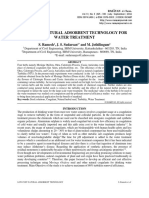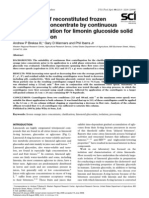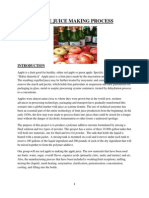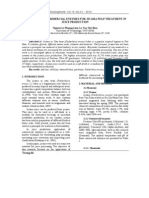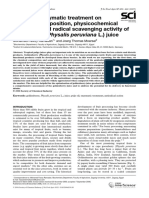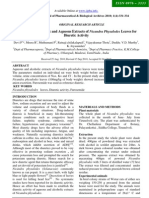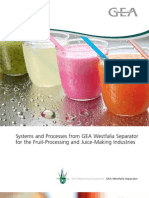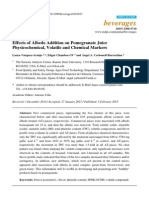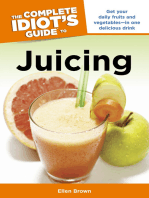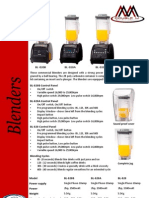0 ratings0% found this document useful (0 votes)
294 viewsComparison of Juice Extractors: Enzymes: Michael Donaldson, PH.D
Comparison of Juice Extractors: Enzymes: Michael Donaldson, PH.D
Uploaded by
Robert RomanThis document summarizes a study that compared the effects of different juice extractors on the enzyme activity levels in extracted carrot juice. The study found that juice extracted via a two-step triturator and hydraulic press had the highest enzyme activity, while centrifugal extractors produced juice with the lowest activity. Among centrifugal juicers, the Omega produced juice with the highest enzyme levels. The People's Press extractor extracted the most juice and produced juice with enzyme activity levels comparable to the best masticating and twin gear juicers. The study provides evidence that juice extraction method affects the "life force" and benefits of fresh juices.
Copyright:
Attribution Non-Commercial (BY-NC)
Available Formats
Download as PDF, TXT or read online from Scribd
Comparison of Juice Extractors: Enzymes: Michael Donaldson, PH.D
Comparison of Juice Extractors: Enzymes: Michael Donaldson, PH.D
Uploaded by
Robert Roman0 ratings0% found this document useful (0 votes)
294 views0 pagesThis document summarizes a study that compared the effects of different juice extractors on the enzyme activity levels in extracted carrot juice. The study found that juice extracted via a two-step triturator and hydraulic press had the highest enzyme activity, while centrifugal extractors produced juice with the lowest activity. Among centrifugal juicers, the Omega produced juice with the highest enzyme levels. The People's Press extractor extracted the most juice and produced juice with enzyme activity levels comparable to the best masticating and twin gear juicers. The study provides evidence that juice extraction method affects the "life force" and benefits of fresh juices.
Original Description:
.........
Original Title
Juice_Extractor_Comparison.pdf
Copyright
© Attribution Non-Commercial (BY-NC)
Available Formats
PDF, TXT or read online from Scribd
Share this document
Did you find this document useful?
Is this content inappropriate?
This document summarizes a study that compared the effects of different juice extractors on the enzyme activity levels in extracted carrot juice. The study found that juice extracted via a two-step triturator and hydraulic press had the highest enzyme activity, while centrifugal extractors produced juice with the lowest activity. Among centrifugal juicers, the Omega produced juice with the highest enzyme levels. The People's Press extractor extracted the most juice and produced juice with enzyme activity levels comparable to the best masticating and twin gear juicers. The study provides evidence that juice extraction method affects the "life force" and benefits of fresh juices.
Copyright:
Attribution Non-Commercial (BY-NC)
Available Formats
Download as PDF, TXT or read online from Scribd
Download as pdf or txt
0 ratings0% found this document useful (0 votes)
294 views0 pagesComparison of Juice Extractors: Enzymes: Michael Donaldson, PH.D
Comparison of Juice Extractors: Enzymes: Michael Donaldson, PH.D
Uploaded by
Robert RomanThis document summarizes a study that compared the effects of different juice extractors on the enzyme activity levels in extracted carrot juice. The study found that juice extracted via a two-step triturator and hydraulic press had the highest enzyme activity, while centrifugal extractors produced juice with the lowest activity. Among centrifugal juicers, the Omega produced juice with the highest enzyme levels. The People's Press extractor extracted the most juice and produced juice with enzyme activity levels comparable to the best masticating and twin gear juicers. The study provides evidence that juice extraction method affects the "life force" and benefits of fresh juices.
Copyright:
Attribution Non-Commercial (BY-NC)
Available Formats
Download as PDF, TXT or read online from Scribd
Download as pdf or txt
You are on page 1of 0
Comparison of Juice Extractors: Enzymes
Michael Donaldson, Ph.D.
Hallelujah Acres Foundation
P.O. Box 2388
Shelby, NC 28151
(704) 481-1700
www.hacres.com
???
1
A Comparison of Juice Extractors: Enzymes
Michael Donaldson, Ph.D., Hallelujah Acres Foundation
Summary
Enzyme activity is a sensitive way to measure the amount of oxidation and degradation
that occurs during carrot juice extraction. Two-step triturator and hydraulic press, twin
gear, masticating, centrifugal basket, and centrifugal pulp-ejecting juicers were all
included in this study. The two-step triturator/press produced juice with the highest
enzyme activity, while centrifugal extraction produced juice with the lowest enzyme
activity. The Green Life juicer did almost as well as the press-type extractors, while the
Champion juicer was better than all of the centrifugal juicers. Of the 4 centrifugal
juicers, the Omega produced the juice with the highest enzyme activity. Average
amylase activity from the Norwalk juicer was 1.5-fold higher than the Omega, and 3-fold
higher than in the Juiceman Jr. Average peroxidase activity from the Peoples Press was
about 20% higher than the Norwalk or Green Life juicers, about 50% higher than the
Omega, and about 2.5-fold higher than the Juiceman II or Juiceman Jr. The Peoples
Press also extracted the most juice, 1.5-fold more than the Green Life juicer, making it
the top choice for both quality and quantity of juice produced.
Introduction
Which juice extractor is the best? That question has been asked many times. By what
criteria would you judge one machine better than another? Some juicers may be easier
and quicker to use and clean up, but our objective here is to answer this question
scientifically, from a living foods perspective.
Living foods are about enzymes. Living foods have many beneficial properties, but what
sets them apart are their active enzymes. Rather than choosing to analyze mineral and
vitamin content of freshly extracted carrot juice, this study focuses on the enzymatic
activity of the juice.
How much life is in the juice after extraction? Does one type of juicer deactivate more
enzyme activity than another type? If so, how much more? Do certain juicers preserve
the enzyme activity longer, making it possible to juice less frequently? Is it better to
refrigerate or freeze juice overnight? Do organically produced carrots have more enzyme
activity? Which juicer produces the most juice? These questions are all answered in this
study.
Materials and Methods
Supplies
Produce. Bunny Luv carrots, purchased in a 50 lb bag, were used for most experiments.
Organic Bunny Luv carrots, and a grocery store brand of carrots were also purchased for
comparison to the large juicing carrots.
2
Chemicals and equipment. Reagents were all purchased from Sigma Chemical, Inc.
(St. Louis, MO). Distilled, ozonated water was used for all buffer preparation. Oxygen
was obtained from Kings Mountain Home Health Supply Co. (Kings Mountain, NC). A
spectrophotometer (Spectronic 21-UVD) was rented from Spectronic Instruments
(Rochester, NY) for analysis of the assays.
J uice extraction
Juicers. Eight models of juicers were used in this study (see Table 1). Two step
triturator and hydraulic press, twin gear, masticating, centrifugal basket, and centrifugal
pulp-ejecting juicers were all included, representing all the major types of juice extractors
currently on the market.
Table 1. Description of juice extractors.
Juicer Type Operation RPM
Norwalk, Mdl 260 Grinder and hydraulic press Batch 3,600
Peoples Press Hydraulic press, with Champion as grinder Batch 1,725
Green Life Twin gear, low heat and speed Continuous 110
Champion Masticating Continuous 1,725
Omega Centrifugal basket, pulp retaining Batch 3,600
Le Equip Centrifugal, pulp ejecting Continuous 3,600
Juiceman II Centrifugal, pulp ejecting Continuous 6,300
Juiceman Jr. Centrifugal, pulp ejecting Continuous 3,600
Juice preparation. Carrots were peeled and rinsed in cold water. Large carrots were
sliced into at least 3 lengthwise pieces. Approximately 10 pounds of carrots were
prepared and mixed together for testing the 8 juicers. This ensured that one carrot would
not unduly influence the results from a single juicer. 6-8 ounces of juice were prepared
with each machine. Juice was stored in test tubes in ice water until assayed. For volume
of extracted juice measurements, approximately 2 pounds of carrots were prepared per
juice extractor. Pulp was removed from inside the Champion and Norwalk juicers for
pressing to determine the maximum yield using the Peoples Press and the Norwalk
press.
Enzymatic assays.
-amylase. Amylase was analyzed using a kit (Procedure No. 577) from Sigma
Chemical, Inc. Briefly, 1 ml of reagent was mixed with 0.1 ml of sample. Readings were
taken at 405 nm over 10 minutes with the spectrophotometer. The maximum slope was
used to determine the activity, using 8.6 mM
-1
cm
-1
as the extinction coefficient of
p-nitrophenyl at 25C. 1 unit of amylase activity will release 0.8 mole of p-nitrophenyl
phosphate from 1 mole of substrate, 4,6-ethylidene-(G
7
)-p-nitrophenyl (G
1
)- -D-
maltoheptaside per minute at 25C, pH 7.0.
Peroxidase. Peroxidase was analyzed using a procedure from the Worthington
biochemical manual of enzyme assays (http://www.worthington-biochem.com/manual).
Briefly, 25 l of 0.25% o-dianisidine, 20 l of 0.3% hydrogen peroxide, and 1.0 ml of 0.2
3
M potassium phosphate buffer, pH 7.0 were mixed in a 1 ml semi-micro cuvette. The
potassium phosphate buffer was oxygenated for at least 10 minutes prior to use. 20 l of
carrot juice, or 50 l of a 7-fold dilution of carrot juice were assayed. Readings were
taken at 460 nm every 15 seconds for 3 minutes with the spectrophotometer. The
maximum slope was used to determine peroxidase activity, using 11.3 mM
-1
cm
-1
as the
extinction coefficient of o-dianisidine. 1 unit of enzymatic activity will oxidize 1 mole
of o-dianisidine per minute at 25C, pH 7.0
Results
All juicer extractors had several parts to clean. The centrifugal juicers were the quickest
and easiest to use, taking very little effort to feed the carrots into the machine. The
Champion and Norwalk were fairly easy to feed carrots, while the Green Life took the
most effort. The batch operation of the Omega, Peoples Press, and Norwalk make it
more difficult to make a large volume of juice. Clean up takes almost the same amount
of time for each juice extractor. The easiest machine to clean was the Norwalk, with its
high quality, non-staining stainless steel. There were no fine mesh steel screens to clean
with the Peoples Press or the Norwalk. However, both presses require the washing of a
bag that was used for pressing. The two-step trituration/press process does take more
effort overall.
Fresh juice enzyme activity
Carrot juice was initially screened for activity of six enzymes. Levels of cellulase,
tyrosine oxidase, glucose oxidase, and L-amino acid oxidase activities were very low in
carrot juice. L-amino acid oxidase could only be detected in juice produced by the Green
Life or Norwalk juicers, but not from the other machines. Of the six enzyme activities
investigated, only peroxidase and amylase activities were high enough to be of practical
use in evaluating fresh juice. Amylase is an enzyme that breaks starch down into the
disaccharide maltose. Amylase is present in the saliva and begins the digestion of
complex carbohydrates. Hydrogen peroxide is generated as a byproduct of aerobic
metabolism; it is a reactive oxygen species which causes free radical damage and etabolic
aging. By reducing H
2
O
2
(hydrogen peroxide) to H
2
O (water) peroxidase helps protect
our bodies from oxidative damage and keeps us feeling younger.
As shown in Figure 1, there were significant differences in peroxide and amylase
activities in carrot juice produced by the eight machines. The overall trend was for the
two step triturator/press to produce juice with the highest enzyme activity, while
centrifugal extraction produced juice with the lowest enzyme activity. The Green Life
juicer did almost as well as the press-type extractors, while the Champion juicer was
better than all of the centrifugal juicers. Of the 4 centrifugal juicers, the Omega produced
the juice with the highest enzyme activity. Average amylase activity from the Norwalk
juicer was 1.5-fold higher than the Omega, and 3-fold higher than in the Juiceman Jr.
Average peroxidase activity from the Peoples Press was about 20% higher than with the
Norwalk or Green Life juicers, about 50% higher than with the Omega, and about
2.5-fold higher than the Juiceman II or Juiceman Jr. juice extractors.
4
Figure 1. Enzyme activity of fresh carrot juice produced in various juicers. Data is the
average of 3 independent samples, with the standard deviation shown as error bars.
Enzyme activity of stored juice
An important question for people is whether fresh juice can be stored. Claims have been
made that the type of juicer will affect the storage-life of fresh juice. Samples of juice
were stored in completely full test tubes (no foam), covered with plastic wrap at 4C.
Separate tubes were removed and assayed for peroxidase and amylase activities after 1, 2
and 4 days. There was no overall trend in which type of juicer maintained enzyme
activity in the juice the best. The Norwalk and Peoples Press were the only juicers in the
top four juicers for both enzyme tests. Two of the centrifugal juicers did almost as well
as the Norwalk press (see Table 2). In this particular test neither enzyme was degraded to
a large extent after 4 days (30% loss for amylase, < 10% loss for peroxidase). The
stability of peroxidase is well known; peroxidase has been used extensively in
biochemical applications for this reason.
Table 2a. Stability of -amylase in carrot juice stored in refrigerator.
Activity, U/L Percent of amylase measured at:
Juicer Day 0 Day 1 Day 2 Day 4 Average RANK
Norwalk 29.6 120% 97% 100% 105.8% 1
Juiceman II 23.6 117% 91% 109% 105.6% 2
Juiceman Jr 8.7 111% 104% 78% 97.6% 3
Press 34.2 100% 85% 75% 86.6% 4
Omega 23.8 95% 77% 76% 82.5% 5
Champion 27.2 100% 62% 86% 82.4% 6
Le Equip 13.5 92% 70% 70% 77.5% 7
Green Life 36.1 88% 72% 71% 77.2% 8
0
200
400
600
800
1000
1200
1400
People's
Press
Norwalk Green Life Champion Omega Juiceman
II
Le Equip Juiceman
Jr
P
e
r
o
x
i
d
a
s
e
A
c
t
i
v
i
t
y
(
U
/
L
)
0.0
5.0
10.0
15.0
20.0
25.0
30.0
35.0
40.0
45.0
A
m
y
l
a
s
e
A
c
t
i
v
i
t
y
(
U
/
L
)
Peroxidase
Amylase
5
Table 2b. Stability of peroxidase in carrot juice stored in refrigerator.
Activity, U/L Percent of peroxidase measured at:
Juicer Day 0 Day 1 Day 2 Average RANK
Norwalk 1,128 131% 121% 126% 1
Omega 903 112% 118% 115% 2
Press 1,331 110% 117% 114% 3
Green Life 1,081 123% 104% 113% 4
Juiceman II 524 99% 121% 110% 5
Champion 1,235 95% 119% 107% 6
Le Equip 541 111% 96% 103% 7
Juiceman Jr 689 104% 88% 96% 8
Frozen or fridge?
Is it better to store juice in the refrigerator or the freezer? The peroxidase and amylase
activities of carrot juice were assayed after storage overnight in a refrigerator or in the
freezer. Our results show that freezing preserved the peroxidase activity better, while
refrigeration preserved more amylase activity.
Organic?
Carrot juice was prepared using the Champion juicer as a grinder and the Peoples Press
from three batches of carrotsgrocery store brand, Bunny Luv juicing carrots from a 50
lb bag, and organically produced Bunny Luv carrots, purchased from a grocery store. In
Table 3 it shows that all three samples contained similar amounts of peroxidase activity.
However, the organic carrots had twice the amount of amylase activity as the other two
samples.
Table 3. Enzyme activity of carrots from 3 sources.
Source Amylase Activity (U/L) Peroxidase Activity (U/L)
Grocery store 36.4 1,351
Bunny Luv 32.0 1,115
Organic 62.6 1,018
Volume
Each of the eight juicers was tested for the amount of juice produced (see Figure 2).
Also, the amount of juice that could be further extracted from the pulp using a hydraulic
press was measured. The combination of the Champion triturator with the Peoples Press
produced the most juice, converting about 0.67 g juice per gram of carrot (10.7 ounces
per pound of carrots). The Juiceman Jr., Omega, and Juiceman II produced almost as
much juice as the Norwalk press, about 0.54 g juice per gram of carrot (8.6 ounces per
pound of carrots). The Champion and Green Life juicers gave very similar results, about
0.45 g juice per gram of carrot (7.2 ounces per pound of carrots).
When the pulp was extracted using the Peoples Press, 20-65% more juice was extracted.
Only 20% more could be extracted after initially pressing with the Norwalk, due to its
6
efficient extraction. Only 30% more juice could be obtained from the Green Life juice
extractor. The centrifugal juicers shred the carrot very finely and the
masticating/triturator type juicers grind the pulp into a consistency close to apple butter,
but the Green Life juicer produced pulp that was chunky and had a relatively large
particle size. These large particles did not release their juice when subjected to high
pressure. About 35-40% more juice was obtained from the centrifugal juicers. 65%
more juice was obtained from the pulp from the Le Equip juicer. It appears to shred
finely but not to extract the juice very efficiently.
Figure 2. Volume of carrot juice produced. Carrot extraction was done in the juicer
listed. Pulp extraction was done with People's Press to determine the amount of
extractable juice remaining in the pulp. All data is the average of 3 runs, with the
standard deviation shown.
30%
35%
40%
45%
50%
55%
60%
65%
70%
75%
80%
P
e
o
p
l
e
's
P
r
e
s
s
N
o
r
w
a
l
k
J
u
i
c
e
m
a
n
J
r
O
m
e
g
a
J
u
i
c
e
m
a
n
I
I
C
h
a
m
p
i
o
n
G
r
e
e
n
L
i
f
e
L
e
E
q
u
i
p
C
a
r
r
o
t
j
u
i
c
e
e
x
t
r
a
c
t
e
d
,
w
e
i
g
h
t
%
Pulp extraction
Carrot extraction
7
Discussion
Enzymes are the catalysts that perform all of the reactions in our bodies. Life at the
cellular level depends on enzymes. Our bodies make the enzymes necessary for life from
the food that we eat. Proteins are digested and broken down into individual amino acids,
which then are reassembled into the proteins that our bodies need.
The above paragraph is standard biochemical dogma. However, we know, both from
experience and research that people who consume mostly enzyme-rich living foods enjoy
good health. In fact, the Hallelujah diet and other similar mostly raw, living food diets
have restored people to good health when they were sick. Many people experience even
better health than before they became sick.
In addition to our experience, research has shown that whole proteins are absorbed
through the gut lumen into the bloodstream. Systemic enzyme therapy with large oral
doses of enzymes can be helpful in recovering from an acute injury, as many world-class
athletes know and practice (see Lopez et al. [1]).
So then, do we need enzymes in our food? While not thoroughly proven, the information
I have leads me to choose to eat foods that are enzymatically active. Any food
processing that preserves (dehydration) or increases enzyme activity (such as
fermentation and sprouting) would be beneficial, while cooking would be detrimental.
Several factors have been considered to be important in making good juice. Exposure to
oxygen in the air, heat production, and foaming are all important factors to consider.
Enzyme activity is a very good way to measure the amount of degradation that has
occurred during juice extraction. It takes into account all the destructive effects of
oxygen, heat, electromagnetic effects, and other factors. It tells you how much life is
still in the juice.
Using enzyme content as our criteria, our results show that a two-step triturator/press is
the best method to prepare fresh juice. This is not a surprise, since Max Gerson [2, p
217] and Norman Walker [3, p 14-15] both advocated this method of juice preparation
for maximum benefit. The Green Life juicer is the next best extractor, with the
Champion and Omega following. Finally, the pulp-ejecting centrifugal juice extractors
are last. These juicers still produce enzyme-containing juice, but the enzyme loss is
much greater with these centrifugal juicers. Max Gerson claimed that centrifugal juicers
deactivated enzymes in the process of extracting juice. To our knowledge, this is the first
quantitative investigation of this claim.
The results with the Norwalk and Peoples Press demonstrate that high-speed juice
extraction does not necessarily deactivate enzymes. The speed of the motor or cutting
blades does not reveal how much degradation will occur using a specific machine. The
generation of heat by the high speed does not appear to cause any loss in enzymatic
activity. This makes sense, since enzymes are heat stable at least to body temperature
(37C / ~99F). No juicer heated the juice to this extent. Rather, it is the introduction of
8
air into the juice extraction process that is the more important question. Centrifugal
juicers pull copious amounts of air through the machine during the juicing process.
The amount of foam produced during juicing is very critical. The Norwalk and Peoples
Press generate very little foam with most of the bubbles being large in diameter. Other
juicers produce more foam with much smaller bubbles. The more foam and smaller the
bubbles, the greater the exposure to air and thus oxidation. There is a tremendous
amount of surface area in foam for oxidation to take place. Any juicer that squeezes juice
through a metal screen will cause substantial amounts of foam, resulting in greater losses
of nutrients due to oxidation.
Our results did not show a strong trend in which type of juicer produced juice that stored
well without loss of enzymatic activity. The Norwalk and Peoples Press performed well,
but two centrifugal juicers also maintained amylase activity well. Perhaps other factors
are more important in storing juice. The presence or absence of oxygen in the bottle may
be the most critical factor. Enzymes which oxidize the nutrients in juice require oxygen
for their activity. Without oxygen the nutrients are quite stable. The best storage
methods would be to eliminate any air from the container by filling the container
completely, to use a vacuum sealing container, or to flush the container with nitrogen to
eliminate the oxygen. Reducing bacterial contamination by using clean jars and peeling
and rinsing the carrots may be very helpful for storage of juice as well.
Claims have been made that the Green Life juice extractor produces juice that can be
stored for longer periods of time compared to other juicers. It is possible that nutrients
other than enzymes are preserved longer with the Green Life juicer. However, enzymes
are generally at least as sensitive to oxidation as other nutrients so their activity should be
a good indicator of the status of other nutrients as well.
In addition to producing enzyme rich juice, the Peoples Press, in combination with the
Champion (used as a homogenizer), also extracted the most juice from the carrots (1.5
times as much as the Champion or Green Life), making it the best overall choice for juice
quantity and quality. The centrifugal juicers produce almost as much juice as the
Norwalk, but quality is much lower. For committed juicing an extractor that produces the
highest quality juice is recommended. The Peoples Press, Norwalk, and Green Life all
meet the standard of high quality juice. To get the most enzymes out of your carrots the
best juicer is the combination of the Champion, used as a grinder, and the Peoples Press.
When considering the purchase of a juicer, several aspects need to be considered:
quantity and quality of juice, ease of use, time required for juicing and clean-up, price,
and health status of the user. Though the Norwalk or Peoples Press yield the best juice,
a higher level of dedication is needed for this more involved process. For a beginner a
good quality single step juicer may be the best overall choice.
Acknowledgements
Thanks to Rev. George Malkmus, Sam Stoltzfus, and Dr. William Welles, D.C. for
allowing the use of their juicers to make this study possible. Funding was provided by
9
the Hallelujah Acres Foundation, a non-profit National Heritage-administered foundation
for research. For more information see http://www.hacres.com/html/foundation.html
References
1. Lopez, DA, Williams, RM, Miehlke, M: Enzymes: The fountain of life. The Neville
Press, Charleston, SC, 1994.
2. Gerson, M: A cancer therapy: results of fifty cases: a summary of 30 years clinical
experimentation. Station Hill Press / Gerson Institute, Bonita, CA, 1958.
3. Walker, NW: Fresh vegetable and fruit juices. Norwalk Press, Prescott, AZ, 1970.
The Hallelujah Acres Foundation: Who We Are
Rev. George Malkus established the Hallelujah Acres Foundation in 1997. Michael
Donaldson was hired in 1998 as director of research. Our purpose is to conduct research
to document the healing power of foods in the context of a Biblically-based vegetarian
lifestyle.
Research projects completed include a vitamin B
12
screening, a fibromyalgia diet
intervention study, and a diet survey. Current and future studies include an intervention
study for heart attack victims, a retrospective cancer survival study, and a long-term
tracking registry of Hallelujah vegetarians.
The Hallelujah Acres Foundation is a Donor Advised Fund under the administrative and
tax umbrella of The National Heritage Foundation, which is a 501 (c)(3) tax-exempt
organization. All gifts to the Hallelujah Acres Foundation are tax deductible.
This information has been provided to you free of charge. If you have benefited from
this information please pass it along to others who you think would also benefit. Also,
please consider sending a donation to the Hallelujah Acres Foundation to help offset our
costs in performing these tests and providing the juicer study results for you. By
donating to the foundation you become a part of the spearhead that is bringing about a
paradigm shift in the way we think about food, disease, sickness, and health. Contact
Hallelujah Acres today for information about donating to the Hallelujah Acres
Foundation.
Hallelujah Acres Foundation
P.O. Box 2388
Shelby, NC 28151
(704) 481-1700 http://www.hacres.com/html/foundation.html
You might also like
- Determinatio of Acid Contents in Sour FruitsDocument12 pagesDeterminatio of Acid Contents in Sour Fruitsamol Akolkar ( amolpc86)70% (20)
- This Study Resource Was: Worksheet CDocument7 pagesThis Study Resource Was: Worksheet CBetty CooperNo ratings yet
- Chapter 3 Biochemistry Exam: Amino Acids, Peptides, and ProteinsDocument17 pagesChapter 3 Biochemistry Exam: Amino Acids, Peptides, and ProteinsJessie90% (77)
- Article:: Ii. Oxidation of Sugars by An Carbohydrate Metabolism of Citrus FruitsDocument7 pagesArticle:: Ii. Oxidation of Sugars by An Carbohydrate Metabolism of Citrus FruitsJeremia Kevin EmEmNo ratings yet
- Citrus Juice Extraction Systems Effect oDocument8 pagesCitrus Juice Extraction Systems Effect ohanane.azzouziNo ratings yet
- Processing and Storage Effects On Orange Juice Aroma: A ReviewDocument13 pagesProcessing and Storage Effects On Orange Juice Aroma: A ReviewSwetha RameshNo ratings yet
- A Mechanical Method Fob Extracting Tamarind PulpDocument2 pagesA Mechanical Method Fob Extracting Tamarind PulpJamesNo ratings yet
- Dam2013 RagsDocument8 pagesDam2013 Ragstrunghau0164No ratings yet
- Jurnal TekZImDocument10 pagesJurnal TekZImFestus Septian Z. YoesafatNo ratings yet
- Recipes-For-Living JuiceDocument34 pagesRecipes-For-Living Juicehandehoh123100% (4)
- Low Cost Natural Adsorbent Technology For Water Treatment: S. Ramesh, J. S. Sudarsan and M. JothilingamDocument6 pagesLow Cost Natural Adsorbent Technology For Water Treatment: S. Ramesh, J. S. Sudarsan and M. JothilingamCleto TundumulaNo ratings yet
- Limonoids ImpDocument6 pagesLimonoids Impnishi@sainiNo ratings yet
- IJPPR, Vol 7, Issue 4, Article 23Document8 pagesIJPPR, Vol 7, Issue 4, Article 23madhujayarajNo ratings yet
- Lemon Juice Bioactivity in Vitro Increased With Lactic Acid FermentationDocument14 pagesLemon Juice Bioactivity in Vitro Increased With Lactic Acid FermentationalessandracNo ratings yet
- Ref 3Document12 pagesRef 3ANDRES FELIPE MOSQUERA MARTINEZNo ratings yet
- Clarification Effects in A Functional Copoazu BeverageDocument7 pagesClarification Effects in A Functional Copoazu Beveragemarco mori mojalottNo ratings yet
- GEA WS Juice-BrochureDocument48 pagesGEA WS Juice-BrochureMargo SmithNo ratings yet
- Effect of Enzymatic Hydrolysis of Pineapple Fruit Pulp On Yield and Analytical Parameters of Derived JuiceDocument9 pagesEffect of Enzymatic Hydrolysis of Pineapple Fruit Pulp On Yield and Analytical Parameters of Derived JuiceYURINo ratings yet
- RRLDocument7 pagesRRLKrisxan Mae NarteNo ratings yet
- The Potential Of: ToothwearDocument6 pagesThe Potential Of: Toothwearasti findaNo ratings yet
- Yukot, DuDocument13 pagesYukot, DuNyanko SorianoNo ratings yet
- Articulo 3 FinalDocument15 pagesArticulo 3 FinaljessikabapaNo ratings yet
- Effect of Coating and Wrapping Materials On The Shelf Life of Apple Malus Domestica CV BorkhDocument11 pagesEffect of Coating and Wrapping Materials On The Shelf Life of Apple Malus Domestica CV BorkhNadia Aprili PutriNo ratings yet
- Enzymes Lab ReportDocument3 pagesEnzymes Lab Reporttanu96tp59520% (1)
- UC Davis PJ Composition JAFC Vol 40 No 5 1992Document6 pagesUC Davis PJ Composition JAFC Vol 40 No 5 1992Asher Lee StreetsNo ratings yet
- Impact of CommercIal PectolytIc Enzymes White Dragon FruitDocument7 pagesImpact of CommercIal PectolytIc Enzymes White Dragon FruitNguyễn QuangNo ratings yet
- Apple Juice Making ProcessDocument33 pagesApple Juice Making ProcessCt Hajar71% (14)
- Process For The Preperation of Pinapple Stem BromelainDocument4 pagesProcess For The Preperation of Pinapple Stem BromelainChocoCrowbarNo ratings yet
- Phuong LienDocument13 pagesPhuong LienDuyha CaoNo ratings yet
- Effect of Salinity Tomato Fruit: Ripening'Document5 pagesEffect of Salinity Tomato Fruit: Ripening'José Francisco Molina VenegasNo ratings yet
- Juicing Pulping - Role of Enzymes in Fruit Juices Clarification During Processing - A ReviewDocument13 pagesJuicing Pulping - Role of Enzymes in Fruit Juices Clarification During Processing - A ReviewKick_downNo ratings yet
- Ethanol Fermentation From Sweet Sorghum JuiceDocument8 pagesEthanol Fermentation From Sweet Sorghum JuiceanilkumarskalyaneNo ratings yet
- Main Organic Acid Distribution of Authentic Citrus Juices in Turkey (#138557) - 119982Document5 pagesMain Organic Acid Distribution of Authentic Citrus Juices in Turkey (#138557) - 119982Ben WunderNo ratings yet
- Studies On Pasteurized and Concentrated Lime Juice: July 2014Document14 pagesStudies On Pasteurized and Concentrated Lime Juice: July 2014Uttam Kumar DashNo ratings yet
- Physicochemical Characteristics of Orange Juice Samples From Seven C U LtivarsDocument7 pagesPhysicochemical Characteristics of Orange Juice Samples From Seven C U LtivarsRemulo Antonio Baez GonzalezNo ratings yet
- Impact of Enzymatic Treatment OnDocument9 pagesImpact of Enzymatic Treatment OnAlexis GoicocheaNo ratings yet
- Consumption and Market: 2.2. ProcessDocument2 pagesConsumption and Market: 2.2. ProcessDivya YadavNo ratings yet
- Research-Plan Aloe Vera ExtractDocument42 pagesResearch-Plan Aloe Vera ExtractKrishan Carlos CredoNo ratings yet
- University of Kassel-Witzenhausen and University of Göttingen, October 9-11, 2007Document4 pagesUniversity of Kassel-Witzenhausen and University of Göttingen, October 9-11, 2007Behailu FelekeNo ratings yet
- Investigatory ProjectDocument29 pagesInvestigatory Projecttta100% (3)
- Evaluation of Alcoholic and Aqueous Extracts of Nicandra Physalodes Leaves For Diuretic ActivityDocument4 pagesEvaluation of Alcoholic and Aqueous Extracts of Nicandra Physalodes Leaves For Diuretic ActivityThota VijaykumarNo ratings yet
- Proposal Vitamin C Content in FruitDocument10 pagesProposal Vitamin C Content in FruitNurul Ashikin50% (2)
- Antioxidant Properties of Soy SproutsDocument11 pagesAntioxidant Properties of Soy SproutsmemiromeroNo ratings yet
- GEA WS Juice-BrochureDocument48 pagesGEA WS Juice-Brochuresami_bulut542No ratings yet
- Fermented Orange Juice: Source of Higher Carotenoid and Flavanone ContentsDocument10 pagesFermented Orange Juice: Source of Higher Carotenoid and Flavanone ContentsTrúc NguyễnNo ratings yet
- keywords" content="call for paper 2012, hard copy of journal, research paper publishing, where to publish research paper, journal publishing, how to publish research paper, Call For research paper, international journal, publishing a paper, IJERD, journal of science and technology, how to get a research paper published, publishing a paper, publishing of journal, publishing of research paper, reserach and review articles, IJERD Journal, How to publish your research paper, publish research paper, open access engineering journal, Engineering journal, Mathemetics journal, Physics journal, Chemistry journal, Computer Engineering, Computer Science journal, how to submit your paper, peer reviw journal, indexed journal, reserach and review articles, engineering journal, www.ijerd.com, research journals, yahoo journals, bing journals, International Journal of Engineering Research and Development, google journals, hard copy of journal,Document4 pageskeywords" content="call for paper 2012, hard copy of journal, research paper publishing, where to publish research paper, journal publishing, how to publish research paper, Call For research paper, international journal, publishing a paper, IJERD, journal of science and technology, how to get a research paper published, publishing a paper, publishing of journal, publishing of research paper, reserach and review articles, IJERD Journal, How to publish your research paper, publish research paper, open access engineering journal, Engineering journal, Mathemetics journal, Physics journal, Chemistry journal, Computer Engineering, Computer Science journal, how to submit your paper, peer reviw journal, indexed journal, reserach and review articles, engineering journal, www.ijerd.com, research journals, yahoo journals, bing journals, International Journal of Engineering Research and Development, google journals, hard copy of journal,IJERDNo ratings yet
- ENZYCORP Product Brochure 2012 en PrintDocument16 pagesENZYCORP Product Brochure 2012 en PrintMarek DvořákNo ratings yet
- Antibacterial and Antioxidant ActivitiesDocument7 pagesAntibacterial and Antioxidant ActivitiesAshwinee KadelNo ratings yet
- Food Chemistry: A. Rodríguez-Bernaldo de Quirós, M. Fernández-Arias, J. López-HernándezDocument4 pagesFood Chemistry: A. Rodríguez-Bernaldo de Quirós, M. Fernández-Arias, J. López-HernándezelisabethNo ratings yet
- Acido Ascorbico en Jugos de Fruta y Su Rata de Perdida Por AlamacenamientoDocument4 pagesAcido Ascorbico en Jugos de Fruta y Su Rata de Perdida Por AlamacenamientoYuliana PerezNo ratings yet
- JurnalDocument5 pagesJurnalChitra OctavinaNo ratings yet
- 19641A0117 Technical SeminarDocument19 pages19641A0117 Technical SeminarHari PrasadNo ratings yet
- Beverages: Effects of Albedo Addition On Pomegranate Juice Physicochemical, Volatile and Chemical MarkersDocument17 pagesBeverages: Effects of Albedo Addition On Pomegranate Juice Physicochemical, Volatile and Chemical MarkersshishirchemNo ratings yet
- Tookey 1968 Proteinasas de Jarilla ChocolaDocument3 pagesTookey 1968 Proteinasas de Jarilla ChocolaFelipeNo ratings yet
- Sem2 Senior Lab6Document13 pagesSem2 Senior Lab6Yusof SundangNo ratings yet
- Jana QatatoDocument12 pagesJana QatatoHasan QatatoNo ratings yet
- The Complete Idiot's Guide to Juicing: Get Your Daily Fruits and Vegetables—in One Delicious DrinkFrom EverandThe Complete Idiot's Guide to Juicing: Get Your Daily Fruits and Vegetables—in One Delicious DrinkRating: 3 out of 5 stars3/5 (1)
- 51 Juicing Recipes: Pure Juicing for Glowing Skin, Immune Boosting and Recovery: Calories-Sodium-Carbs-Fiber-Sugar-Protein Count For Each Recipe And Much MoreFrom Everand51 Juicing Recipes: Pure Juicing for Glowing Skin, Immune Boosting and Recovery: Calories-Sodium-Carbs-Fiber-Sugar-Protein Count For Each Recipe And Much MoreRating: 2 out of 5 stars2/5 (1)
- Fixing and Mounting Of: RADIK and KORALUX RadiatorsDocument20 pagesFixing and Mounting Of: RADIK and KORALUX RadiatorsRobert RomanNo ratings yet
- Sharp Dust SensorDocument3 pagesSharp Dust SensorRobert RomanNo ratings yet
- How To Replace Torn Off Buttons: If There Is A Hole, Mend ItDocument2 pagesHow To Replace Torn Off Buttons: If There Is A Hole, Mend ItRobert RomanNo ratings yet
- Electrolux z7040 PDFDocument8 pagesElectrolux z7040 PDFRobert RomanNo ratings yet
- PL1.2-12 (12V1.2AH) : Valve Regulated Lead Acid BatteryDocument2 pagesPL1.2-12 (12V1.2AH) : Valve Regulated Lead Acid BatteryRobert RomanNo ratings yet
- BL-020B Control PanelDocument1 pageBL-020B Control PanelRobert RomanNo ratings yet
- Centre de Premiere Doze Coca-ColaDocument27 pagesCentre de Premiere Doze Coca-ColaRobert RomanNo ratings yet
- Lamsal 2007Document9 pagesLamsal 2007CHRISTELLE MARINA KOUAKOUNo ratings yet
- S.3 Biology Chapter 5Document85 pagesS.3 Biology Chapter 5Fung Shan CheungNo ratings yet
- Collected Coursework Problems in Biochemical Engineering BlanchDocument6 pagesCollected Coursework Problems in Biochemical Engineering Blanchbcqy65mx100% (2)
- FEBS Letters - May 07 1984 - Yates - Methods of Enzymatic Analysis 3rd Edn Volume 1Document1 pageFEBS Letters - May 07 1984 - Yates - Methods of Enzymatic Analysis 3rd Edn Volume 1abanoub ebaidNo ratings yet
- Screening of Some Marine-Derived Fungal Isolates For Lignin Degrading Enzymes (Ldes) ProductionDocument9 pagesScreening of Some Marine-Derived Fungal Isolates For Lignin Degrading Enzymes (Ldes) ProductionkhanNo ratings yet
- Enzymology 3rd Jan 2024 3Document41 pagesEnzymology 3rd Jan 2024 3panchalveer37No ratings yet
- Bio462 Practical 3Document10 pagesBio462 Practical 3kimnamin9No ratings yet
- Isolation of Protease Enzyme From Chayote Fruit (Sechium Edule (Jacq.) SW.) With Ammonium Sulfate Fractination MethodDocument5 pagesIsolation of Protease Enzyme From Chayote Fruit (Sechium Edule (Jacq.) SW.) With Ammonium Sulfate Fractination MethodNhư QuỳnhNo ratings yet
- SERUM GST AND EFFECT Cl4C IN RATDocument9 pagesSERUM GST AND EFFECT Cl4C IN RATToonny JasshNo ratings yet
- Ncert Line by Line 28updated29-286-299Document14 pagesNcert Line by Line 28updated29-286-299123No ratings yet
- Streptococcus Lactis PDFDocument7 pagesStreptococcus Lactis PDFputri harkitnasyahNo ratings yet
- Caspase 3 - 7 Kit AssayDocument3 pagesCaspase 3 - 7 Kit AssayrinjaniNo ratings yet
- Presentation MicrofluidicsDocument8 pagesPresentation MicrofluidicsDorothy LeeNo ratings yet
- Grade 8 Chapter 4 EnzymesDocument18 pagesGrade 8 Chapter 4 EnzymesRaeed FarshidNo ratings yet
- Rigor Phase ShrimpDocument8 pagesRigor Phase ShrimpSeptie DevinaNo ratings yet
- Lab Report 1 Microbial PhysiologyDocument13 pagesLab Report 1 Microbial PhysiologyFern S. PhratchayaNo ratings yet
- Protease ELU Activity AssayDocument2 pagesProtease ELU Activity AssayYunita KurniatiNo ratings yet
- CelG From Clostridium Cellulolyticum A Multi Domain Endoglucanase Acting Efficiently On Crystalline CelluloseDocument7 pagesCelG From Clostridium Cellulolyticum A Multi Domain Endoglucanase Acting Efficiently On Crystalline CelluloseDavid MeadNo ratings yet
- KIM Et Al. 2018. Quitosanasa y QuitinasaDocument37 pagesKIM Et Al. 2018. Quitosanasa y QuitinasaKirianova GodoyNo ratings yet
- C 1.1 SL EnzymesDocument37 pagesC 1.1 SL Enzymesswapnaboddu666No ratings yet
- Enzymes PPT BioDocument22 pagesEnzymes PPT Biovoyav37617No ratings yet
- Processing of Beta GlucanaseDocument8 pagesProcessing of Beta GlucanasedilsahNo ratings yet
- CPB 30103 Biochemical Engineering UniKL MICET Experiment 2: Enzyme Assays and Factors Affecting Enzyme Activity Full Lab ReportDocument10 pagesCPB 30103 Biochemical Engineering UniKL MICET Experiment 2: Enzyme Assays and Factors Affecting Enzyme Activity Full Lab ReportSiti Hajar MohamedNo ratings yet
- Therapeutic Drug Monitoring of Levetiracetam in Daily Clinical Practice: High-Performance Liquid Chromatography Versus ImmunoassayDocument5 pagesTherapeutic Drug Monitoring of Levetiracetam in Daily Clinical Practice: High-Performance Liquid Chromatography Versus ImmunoassayMaria MendozaNo ratings yet
- Antioxidant EnzymesDocument20 pagesAntioxidant EnzymeselhadyegNo ratings yet
- 460 Bai Tap Dien HoaDocument69 pages460 Bai Tap Dien Hoavanhiepk52a100% (1)
- Lab 13 Enzymes Reading PDFDocument8 pagesLab 13 Enzymes Reading PDFLarryDengNo ratings yet
- Exp 3 Enzymology Part 1 Determination of Optimum ParametersDocument5 pagesExp 3 Enzymology Part 1 Determination of Optimum ParametersNur Fadhilah75% (4)










